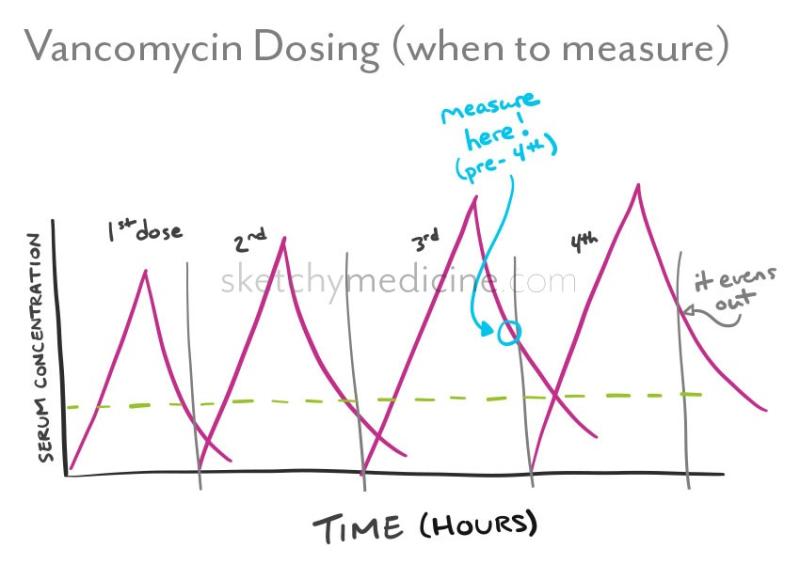When should vancomycin trough be drawn?
The timing of vancomycin trough level monitoring is crucial for assessing the drug's serum concentration and optimizing its therapeutic efficacy while minimizing the risk of toxicity. Here are general guidelines for when vancomycin trough levels should be drawn:
Steady-State Trough Monitoring:
- Vancomycin trough levels are typically drawn just before the fourth dose when the drug has reached a steady state.
- For patients on intermittent dosing (e.g., every 12 hours), the trough should be drawn just before the fourth dose.
Intermittent Dosing:
- For patients receiving vancomycin intermittently (e.g., every 8, 12, or 24 hours), trough levels are usually drawn just before the next scheduled dose.
- Trough levels taken at this time provide an indication of the lowest concentration in the dosing interval, ensuring that the drug remains within the therapeutic range.
Extended Infusion or Continuous Infusion:
- For patients receiving vancomycin via extended or continuous infusion, trough levels can be drawn just before the next dose.
- Extended or continuous infusions are designed to maintain more consistent serum concentrations throughout the dosing interval.
Timing Specifics:
- The exact timing of trough level collection may vary depending on institutional protocols and the specific patient scenario.
- Some institutions specify a specific timeframe, such as drawing trough levels within 30 minutes before the next dose.
Therapeutic Range:
- The therapeutic range for vancomycin trough levels may vary, but it is generally considered effective and safe when maintained between 10 to 20 mcg/mL.
- Certain infections, patient populations, and treatment guidelines may necessitate adjustments to the target range.
Renal Function Monitoring:
- Regular monitoring of renal function, especially in patients with impaired renal function, is crucial as vancomycin is primarily eliminated through the kidneys.
- Dose adjustments may be necessary based on renal function to prevent drug accumulation and potential toxicity.
It's essential to note that these are general guidelines, and specific recommendations may vary based on individual patient factors, the severity of the infection being treated, and local institutional protocols. Healthcare providers should always consider the patient's clinical status, renal function, and other relevant factors when determining the timing of vancomycin trough level monitoring. Additionally, these guidelines may be subject to updates, so consulting the latest literature and institutional policies is recommended.
At what specific point in the treatment cycle should a vancomycin trough level be obtained?
The specific point in the treatment cycle when a vancomycin trough level should be obtained depends on several factors, including:
1. Patient factors:
- Renal function: Patients with normal renal function typically require a vancomycin trough level after the fourth dose, once steady state has been reached. For patients with impaired renal function, the timing may need to be adjusted based on their individual creatinine clearance.
- Severity of infection: For serious infections, a trough level may be obtained earlier, after the second or third dose, to ensure adequate therapeutic levels are achieved quickly.
2. Dosage regimen:
- Dosing frequency: For patients receiving vancomycin twice daily, a trough level is typically obtained before the next dose (pre-dose).
- Dosing interval: For patients receiving vancomycin less frequently than twice daily, the timing of the trough level may need to be adjusted accordingly.
3. Treatment goals:
- Achieving therapeutic levels: The primary goal of monitoring vancomycin trough levels is to ensure that therapeutic levels are achieved and maintained. If the initial trough level is not within the desired range, adjustments to the dosage regimen may be necessary.
- Preventing toxicity: Vancomycin can be toxic at high levels, so monitoring trough levels helps to prevent adverse side effects.
Here are some general guidelines for obtaining vancomycin trough levels:
- For patients with normal renal function and a stable dosage regimen: Obtain a trough level after the fourth dose (pre-dose).
- For patients with impaired renal function or an unstable dosage regimen: Consult a healthcare professional to determine the appropriate timing for obtaining a trough level.
- For patients with serious infections: Consider obtaining a trough level after the second or third dose to ensure therapeutic levels are achieved quickly.
It is important to note that these are general guidelines, and the specific timing for obtaining a vancomycin trough level should be determined by a healthcare professional based on the individual patient's needs and circumstances.
Here are some additional resources that you may find helpful:
- The American Society of Health-System Pharmacists (ASHP): https://www.ashp.org/-/media/assets/policy-guidelines/docs/therapeutic-position-statements/therapeutic-monitoring-vancomycin-adults.ashx
- The Infectious Diseases Society of America (IDSA): https://academic.oup.com/cid/article/49/3/325/496155
- The Society of Infectious Diseases Pharmacists (SIDP): https://sidp.org/resources/Documents/Vanco%20guidelines%202020.pdf













